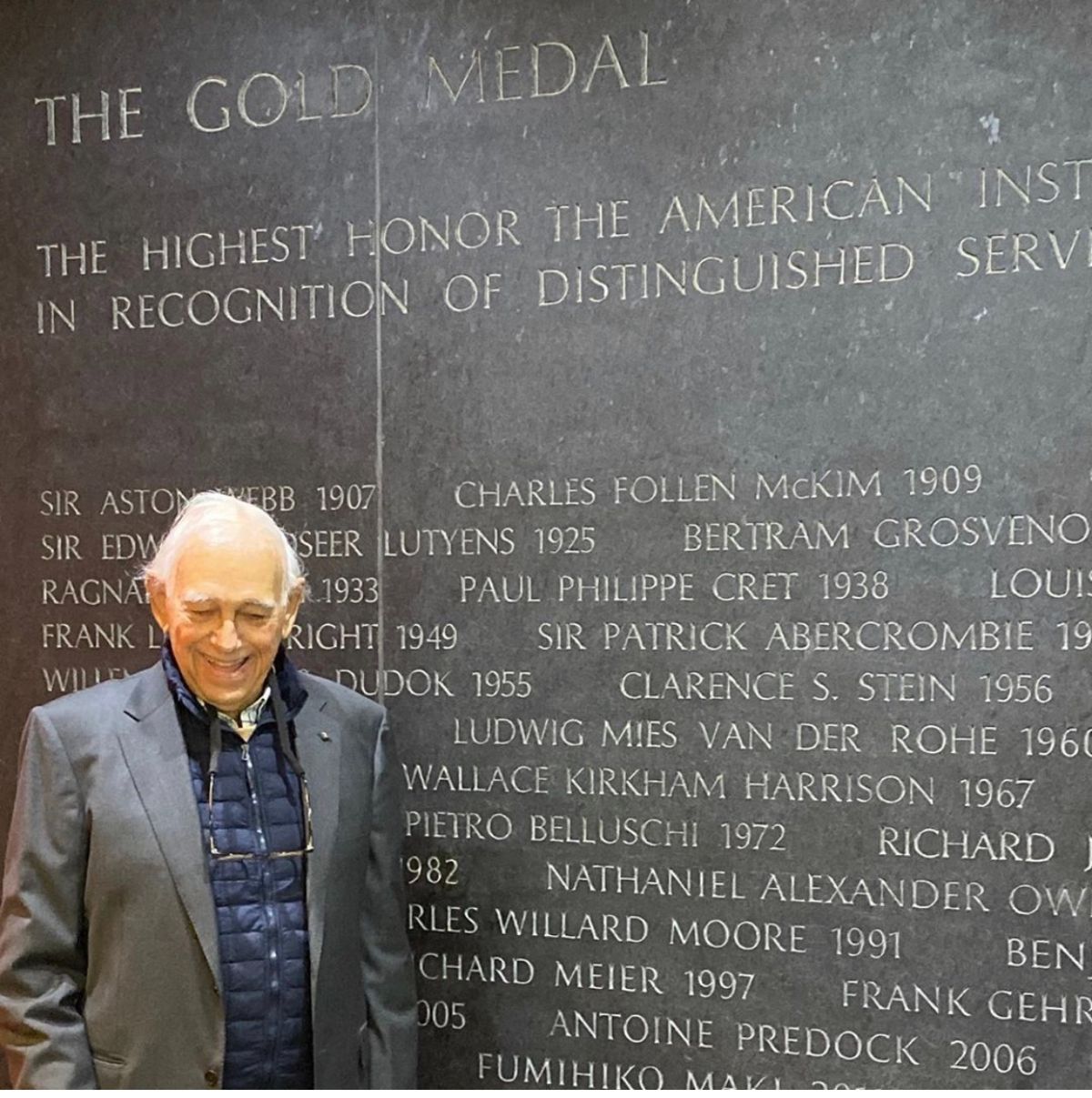ABOUT
A founder of a highly decorated firm celebrated for its human-centered and inspiring design solutions, an educator of an entire generation of design professionals, and a generous creative spirit, James Stewart Polshek, FAIA, has crafted a legacy of idealism etched in every facet of his contributions to both society and the profession.
Born in Akron, Ohio, Polshek earned a Master of Architecture degree from Yale in 1955. The office that Polshek began in 1963 as, James Stewart Polshek Architect evolved through multiple iterations. Following his retirement in 2005, the firm transitioned in 2010 to Ennead Architects. Polshek has fostered an environment wherein design excellence, effective collaboration and rigorous research work in concert to create enduring architecture. His unparalleled vision and leadership has earned the firm countless accolades, including more than 200 design awards, the 1992 AIA Architecture Firm Award, and 15 National Honor Awards for Architecture.
“The true importance of architecture lies in its ability to solve human problems, not stylistic ones. A building is too permanent and too influential on public life and personal comfort to be created primarily as ‘public art’,” Polshek wrote of his design philosophy in Context & Responsibility, a midpoint-career retrospective published in 1988. “Modern abstractions or nostalgia cannot themselves generate ideas for structures of lasting value. Only buildings that serve broadly defined social, political, or cultural objectives can achieve this.”
Over the course of four decades his firms have tackled vital research, cultural, and governmental projects— as well as mundane ones — that have enriched the lives of those in and near them. As the architect for the William J. Clinton Presidential Center in Little Rock, Ark., completed in 2004, Polshek implemented a translucent crystalline bridge to calm the tension between monumentality and accessibility. Clad in glass, the bold cantilevered form is a metaphor for the 42nd president’s progressive ideals.


PUBLICATIONS
Three monographs treat the work of James Polshek and the practice. While the first, Context and Responsibility (1988) and the last, Build Memory (2014) represent James Polshek’s professional evolution in a very personal way, Polshek Partnership Architects (2004) explores the work of the mature collective. The Making of an Architect celebrates the establishment and development of the Graduate School of Architecture, Planning and Preservation, of which James Polshek was Dean from 1972-1987.
Build Memory, Author
In his new book Build, Memory (Monacelli Press), the award-winning architect James Stewart Polshek chronicles his fifty-plus-year career in a unique “memoir of projects” that tells his story through sixteen key building projects. (The title is a play on Vladimir Nabokov’s memoir, Speak, Memory.) Polshek writes a candid personal narrative that details his experience designing landmark projects such as the William J. Clinton Presidential Center in Little Rock, the Newseum in Washington, DC, and the Rose Center for Earth and Space at the American Museum of Natural History in New York. Pentagram’s Paula Scher and team designed the book with a clear, cogent format that complements Polshek’s articulate and accessible writing.

Polshek Partnership, Author, editor
This long-awaited monograph is published as the firm celebrates its fortieth anniversary. Guided by a respect for the environment, the innovative use of materials and technology, a progressive aesthetic vision, and its collaborative structure, the Polshek Partnership has produced a catalog of public works – from theaters and museums to libraries, hospitals, and schools – that collectively ennoble our civic life on a daily basis. Sixteen of the partnership’s most important works are examined in depth from initial conception through design, construction, and completion.

Context and Responsibility, Author, editor
The many projects presented in this first monograph are described first in prose form, arranged chronologically in four phases to connect them to the social attitudes and political realities of their times. The first of these phases is an abbreviated autobiography of James Polshek’s determination to become an architect; the second, third and, fourth phases deal with the evolution of the practice and in chronological order, explain the projects undertaken. Detailed graphic treatments of the project follow, presented in eight contextual categories intended to show that the ability to create architecture that can contribute to the solution of social and environmental issues is achievable.

The Making of An Architect, Author, editor
1981 marked the one-hundredth anniversary of Columbia University’s School of Architecture (now the Graduate School of Architecture, Planning and Preservation). James Polshek was appointed the seventh Dean of the School in 1972. To celebrate the School’s centennial year, he commissioned this book, oversaw its writing and production, wrote the introduction and designed the cover.

Awards
Firm and Personal Awards
The Fulbright Lifetime Achievement Award, 2019
AIA Gold Medal, 2018
Medal of Honor, American Institute of Architects, New York Chapter, 2012
Augustus Graham Medal – Brooklyn Museum of Art 2009
National Design Award in Architecture, Smithsonian Institution Cooper-Hewitt, 2004
President’s Medal, American Institute of Architects, New York Chapter, 2003
Urban Visionary Award – Cooper Union 2003
Architecture Firm Award, American Institute of Architects, 1992
AIA National Honor Awards
The Standard High Line, 2012
Yale University Art Gallery, Kahn Building Renovation, 2010
University of Michigan Biomedical Sciences Research Building, 2007
William J. Clinton Presidential Center, 2006
American Museum of Natural History, Rose Center, 2002
The New York Times Printing Plant, 2001
Queens Borough Public Library, Flushing, 2001
Mashantucket Pequot Museum, 2000
National Inventors Hall of Fame, 1999
Center for the Arts Theater, 1994
Seamen’s Church Institute, 1993
Carnegie Hall, 1988
500 Park Tower, 1986
New York State Bar Center, 1972
AIA/New York Chapter Design Awards
Brooklyn Museum, Entry Pavilion, 2005 American Museum of Natural History, Rose Center, 2002
Barnard College, Sulzberger Hall, 1989
Center for the Arts Theater, San Francisco, 1994
Columbia University Law School, Greene Hall, 1998
Frank Sinatra School of the Arts, 2012
The New York Times Printing Plant, 1997
Newtown Creek Wastewater Treatment Plant, 2011
The Santa Fe Opera Theater, 1999
Seamen’s Church Institute, 1991
William Jefferson Clinton Presidential Center, 2005
Yale University Art Gallery, Kahn Building Renovation, 2008
500 Park Tower, 1985
AIA New York State Design Awards
Newtown Creek Wastewater Treatment Plant, 2011
The Standard High Line, 2011
Frank Sinatra School of the Arts, 2010
Newhouse School of Public Communications III, 2009
Yale University Art Gallery, Kahn Building Renovation, 2007
Brooklyn Museum, Entry Pavilion, 2006
Holland Performing Arts Center, 2006
William Jefferson Clinton Presidential Center, 2005
New York Hall of Science, 2005
Sarah Lawrence College, Heimbold Visual Arts Center, 2005
Lycée Français de New York, 2004
American Museum of Natural History, Rose Center, 2002
Queens Borough Public Library, Flushing, 2002
Columbia University Law School, Greene Hall, 1997
The New York Times Printing Plant, 1997
Government Office Building, Chambéry-le-Haut, France, 1996
National Inventors Hall of Fame, 1996
Brooklyn Museum Renovation, 1995
Center for the Arts Theater, San Francisco, 1994
Carnegie Hall, 1988
